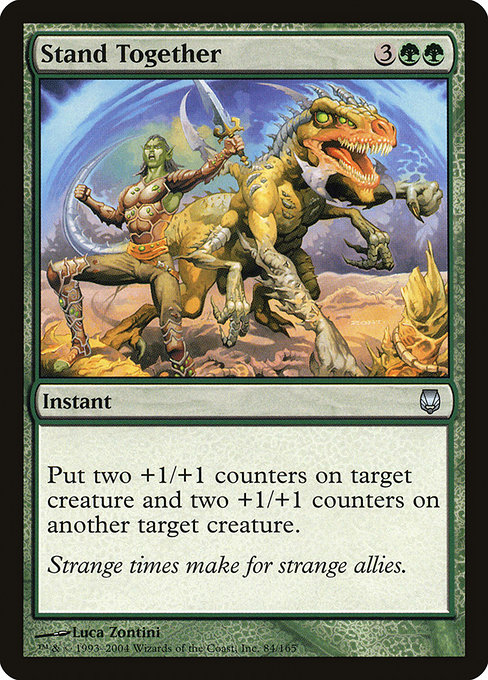
Image courtesy of Scryfall.com
Balancing Complexity and Accessibility in MTG: Demystifying Stand Together
Magic: The Gathering has always thrived on a careful dance between depth and approachability. Some spells threaten to overwhelm a new player with layers of timing, pump, and synergy, while others open doors to clever plays without flooding the table with rules minutiae. Stand Together, a green instant from Darksteel, is a perfect case study in how a card can feel simple at first glance yet reward thoughtful play as you lean into greenshielded versatility 🧙♂️. With a mana cost of 3GG and the ability to place two +1/+1 counters on two different targets, it embodies a design philosophy that invites both casual bursts of action and strategic long-term planning ⚔️.
What Stand Together actually does
- Name: Stand Together
- Set: Darksteel (DST) — a 2004 expansion that helped shape the mid-2000s era of evergreen green themes
- Mana Cost: {3}{G}{G} (cumulative mana value 5)
- Type: Instant
- Rarity: Uncommon
- Text: Put two +1/+1 counters on target creature and two +1/+1 counters on another target creature.
- Color: Green (color identity G)
- Flavor text: “Strange times make for strange allies.”
On the surface, this is a straightforward pump spell—two separate targets, two counters each. But that dual-target requirement matters, especially in the context of green's long-standing counter-accumulation theme. You don’t just pick two creatures; you pick two creatures whose survivability or offense you want to accelerate right now. The card’s two-target constraint nudges you toward planning several turns ahead, balancing immediate board presence with future threat assessment 🔥.
Two targets, many pathways: strategic nuance
Stand Together shines most when you map it onto the evolving battlefield. If you’re facing a wide board, you can garrison two key blockers or two soon-to-be-threshold threats, inflating their power and making combat more lethal for your opponent. If your plan centers around a single, dominant beater, you can empower it alongside a complementary creature to stretch the opponent’s defenses thin. Because you’re placing two counters on two distinct bodies, you can orchestrate a mini-pump-flex that scales with your board’s structure. This makes the spell approachable for newer players (you can see immediate impact) while still offering rich tactical reward for veterans who enjoy value-rich sequencing 🧙♂️.
Another angle is synergy with green’s typical deck-building motifs, such as +1/+1 counters strategies, creature ramp, and token generation. Stand Together doesn’t require you to commit to a long list of combos; instead, it invites you to leverage the counters in ways that echo classic green resilience—outlasting removal, enabling a swing that breaks through stalled defenses, or simply making two creatures imitate a mid-game collective boost. The presence of two separate targets also tees up value in multiplayer formats where damage and blocking decisions are shared across multiple players. In that sense, it’s a small spell with big-stage etiquette: it respects the table’s rhythm while delivering a meaningful payoff ⚔️.
Design clarity meets depth
From a design lens, Stand Together demonstrates how a card can be clear to understand yet rich in decision points. The rules text is concise, and the outcome is easy to visualize on the board. At the same time, choosing the best two targets—especially in the momentum of a crowded battlefield—requires real-time evaluation: which creatures are pivotal now, which ones are likely to be leveraged later, and how does this movement interact with any ongoing combat tricks or tricks you anticipate from your opponent. This is the sweet spot where accessibility and depth coexist, a hallmark of durable card design that invites both fresh faces and seasoned players to crack the puzzle without getting lost in the weeds 🎨.
Flavor, art, and the collector’s perspective
The flavor text—“Strange times make for strange allies”—lends Stand Together a timeless, almost folkloric vibe. It reminds us that MTG isn’t just about crushing the board; it’s about the stories the game tells through its creatures, groups, and alliances. Luca Zontini’s artwork (as credited in the card’s read) captures a moment of unlikely teamwork, which pair well with green’s ecosystem of collaboration and growth. For collectors, Stand Together sits in the uncommon slot from the Darksteel era, a period that’s prized for its distinctive frame and the sense of mid-2000s experimentation. Foil versions appeal to those chasing that extra sparkle on a board-state-affecting spell, even if the effect itself remains delightfully straightforward 🧩.
As a piece of MTG history, Stand Together demonstrates that complexity isn’t the sole measure of impact. Accessibility can coexist with meaningful choice, and the card’s evergreen color identity ensures it remains relevant in a range of green-centered archetypes, from classic +1/+1 counter builds to broader battlefield manipulation. It’s a reminder that the most memorable spells are often the ones you can cast without a rules doctorate, yet you’ll still savor the subtle plays that emerge as the game unfolds 💎.
Promotional note: a small crossover moment
On a slightly cheeky note, this article is also an invitation to explore tangentially related, everyday accessories that fans love—like the stylish Phone Case with Card Holder (Glossy Matte Polycarbonate), which you can find here: Phone Case with Card Holder (Glossy Matte Polycarbonate). It’s a tiny homage to how MTG players juggle cards, tokens, and daily gear with a touch of practical flair 🔥.
Phone Case with Card Holder (Glossy Matte Polycarbonate)More from our network
- Two-Tone MagSafe Phone Case with Card Holder Polycarbonate
- Distant Blue-White Beacon in Sagittarius: Stellar Cartography Milestone
- Kaito’s Pursuit: Mastering Multiplayer in Commander
- Building Pitch Deck Templates for Startups: A Practical Guide
- Crafting Hyperreal Digital Paper with Powerful AI Tools